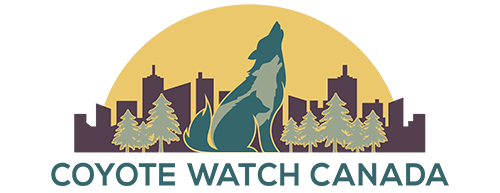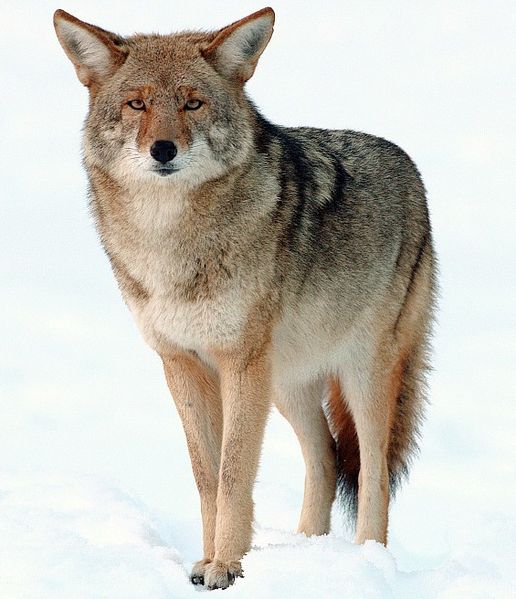With the arrival of denning season, I want to look at how coyotes raise families in the wild—a place free from human harassment and hunting. For me, that place is Yellowstone’s Lamar Valley, where I lived and volunteered during three winters. And where I was lucky enough to observe coyotes.
Coyote courtship starts in December when the snow-covered valley echoes with the beautiful songs of coyotes calling mates or claiming territory.
Mating takes place in February. Coyotes can breed when less than a year old, much earlier than wolves can. Gestation is 63 days, similar to that of wolves.
In April, pups are born in underground dens, many originally dug by badgers and then commandeered by coyotes. While some packs use the same den again and again, a pack may keep up to ten other sites in its territory. Coyotes den for about twelve weeks and then the pups travel with the pack.
An average coyote litter contains six squirmy pups. The size of a litter and the pups’ survival rate depend on the mother’s health, which in turn depends on her winter diet. In Yellowstone, since the return of wolves, the winter diet of many coyotes has improved; they have wolf-killed carcasses to scavenge. (Though this provides more food, dining can be deadly. Forty percent of the coyotes that die in Yellowstone do so at the teeth of wolves who don’t like to share.) The survival of pups also depends on the food supply during the rest of the year. According to Roger DiSilvestro, writing in National Wildlife, the alphas in the pack always eat first. If nothing is left over, pups may starve.
Pups weigh 250 grams at birth. Their eyes open and ears become erect after ten days. Around three to four weeks after birth, pups tumble out of the dark den and into the sunshine of spring. Within about a month they are fully weaned. Within a year, fully grown.
Surviving to that first birthday isn’t easy: Many pups die during their first year. The death rate stays relatively high during the second year then tapers off. Only two or three pups from a litter of six make it to adulthood.
A Yellowstone coyote researcher, Bob Crabtree, saw how one death occurred. As described by DiSilvestro, Crabtree watched a pack of five wolves move in on a group of four coyotes at their Lamar Valley den. After a fifteen-minute scuffle, the wolves ran the coyotes off and began digging out the coyote den. That evening Crabtree found a dead pup at the site.
The pack plays an important part in a coyote’s survival in Yellowstone and elsewhere. Pups have a better shot at surviving when born into a pack since a pregnant female can spend more time resting and thus give birth to healthier pups. And other pack member can help supply pups and their mother with food.
Packs are made up of a mated pair and their offspring that has not yet gone out on their own, according to Marc Bekoff and Michael Wells, who studied coyotes in Grand Teton National Park, Yellowstone’s neighbor to the south. Only one male and one female, the alphas, breed in a pack. Many of the other pack members are the pair’s daughters, since the sons often disperse from the pack after six to nine months, looking to create a family of their own.
The scientists observed that the length of time a coyote family stays together may be determined by how much food is available. When there was a lot of food for the taking in winter, older pups shared a part of their parents’ home range. And if the pups associated with the parents throughout the first winter, there was a good chance that the family would remain together through the following summer.
Based on what I’ve seen and read, I believe that coyotes that raise families in the wild exhibit qualities we would admire in human parents.
• They are committed: a pair may stay together their entire lives.
• They share parenting duties: both provide food for weaned pups.
• They are protective: Pups depend completely on their parents’ for the first few months. If something threatens the young, the parents will move them to another den.
• They are devoted: If one parent is killed, the other will continue to raise the young.
• They help other parents: A coyote pair may adopt pups if the original parents die or become separated from the pups.
This is how coyotes create and raise a family in a natural setting such as Yellowstone. In a future post I’ll look at how they change their behavior as they adapt to an unnatural setting where they are harassed and hunted by humans, the setting where, unfortunately, most of us see coyotes.
Rick Lamplugh is the author of the bestselling In the Temple of Wolves: A Winter’s Immersion in Wild Yellowstone. You can find the book on Amazon Canada and on Amazon US.
Photo credits:
Seven coyote pups by John Harrison. Used with permission
Single coyote pup by John Good, NPS
Adult coyote by Yathin S. Krishnappa. Used with permission




